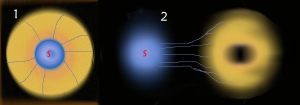I've learned to be cautious when speaking of fantasy, the imagination and sources of inspiration to those who have accepted doctrines of bourgeois normality, because of misunderstandings stemming from the implicit use of different paradigms.My experience of the imagination is that it provides a protective atmosphere to nurture and maintain the self (diagram 1).
However, the theory of the imagination in much of contemporary industrialized culture is that imagination is a thing apart from us (see diagram 2).
In reality, imagination has the role of representing things not as they are, but as they might be. When animals play, they are testing themselves in the realm of the imagination. What works will be retained and will become part of the core self. What doesn't seem to work out whilst enjoying the act of play will be discarded as not part of what that particular animal's repertoire. A human cannot fly, but does so in dreams. Such dreams may have been the origins of aircraft and space travel.
People educated within Western, industrialized cultures view the imagination as a danger and a threat to presently existing reality. In diagram 2, imagination isn't a realm of actual possibility, nor is it a realm of nourishment and safety. Rather, here it represents the self's illusions about reality; its incorrect judgments. To the degree that one is imaginative, one is held to be representing the world as the opposite to what it is (in diagram 2) , rather than representing an extension of what it is (in diagram 1).
Sparring with Mike, I try on a number of different techniques. In a recent video, I see how I tried chasing after him in reverse stance, and came unstuck. My imagination had said, "do it!", and it was certainly worth a try. My knowledge of myself and the world is nourished by such experimentation. This attempt represents one of the thin, blue lines on the first diagram, extending to the outer circumference of my potential for knowledge.
Imagination doesn't corrupt us, it teaches us. In the second model of the "I" and the imagination, the self is separated from the imagination. It relates to it as its opposite, its shadow, its inverse reality. Such an imagination doesn't nourish anything, and it is no wonder that psychiatrists and school teachers feel justified in putting children on corporate drugs in order to try to break the blue network connections between the individual self and its ideas about potential that can never be fulfilled. Following from this second model, "play" only leads to broken arms and sad faces. Reality is what one can see and touch. Reaching out for more just leads to emptiness.
The second model, therefore, may appear more rational on the surface, but its views of human nature are that it is broken. The model itself is consequently also broken.



No comments:
Post a Comment